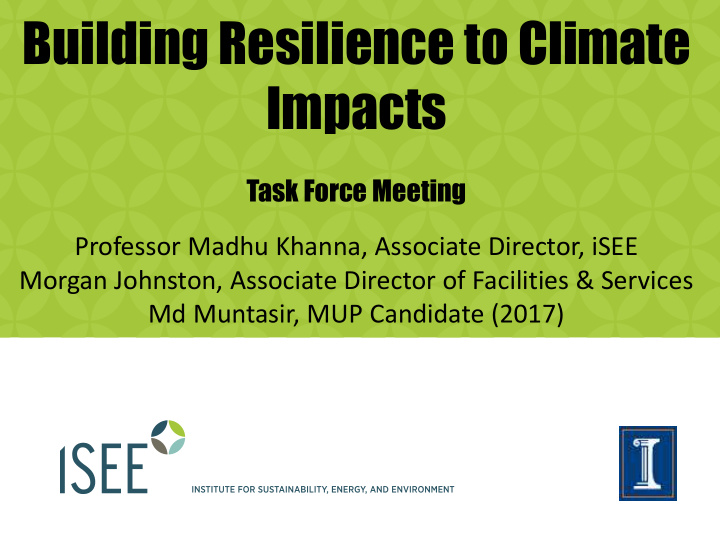



Building Resilience to Climate Impacts Task Force Meeting Professor Madhu Khanna, Associate Director, iSEE Morgan Johnston, Associate Director of Facilities & Services Md Muntasir, MUP Candidate (2017)
Climate Leadership Commitments Signed by University of Illinois at Urbana-Champaign
• The Climate Leadership Commitments are a signature program of Second Nature • Carbon Commitment • Resilience Commitment • Second nature is a non-profit organization with a mission for moving towards sustainability through actions and innovations at institutions of higher education • Formed a Climate Leadership Network that includes more than 600 colleges and universities that have committed to • Take action on climate • Prepare students through research and education to solve the challenges of the 21 st century
Carbon Commitment Signed by Chancellor 2015 iCAP objectives Herman in 2008 are in progress 2015 iCAP approved by Interim Chancellor 2010 iCAP approved Wilson in 2015 by Interim Chancellor Easter in 2010
Resilience Commitment Develop a Climate Action Plan to increase resilience to climate impacts Support a joint campus-community task force to ensure alignment of the Plan with community goals to facilitate joint action Campus-Community resilience assessment Identify thresholds of resilience Targets for meeting milestones for increasing resilience
Resilience Commitment Joint Task Force to meet April 7, 2017
RESILIENCE PLANNING AT OTHER CAMPUSES IN THE US Resilience Planning • A new issue at most campuses • taken up since 2015. Focus on Biodiversity • Resilience plans in the process of formulation mostly by 2020 Emergency response • Different campuses has taken different plan approaches to resilience/adaptation Education and strategy research Outreach and coordination
FOCUS ON BIODIVERSITY UNIVERSITY OF ILLINOIS, CHICAGO UIC climate commitments: Biodiverse Campus. UIC will create a resilient campus landscape supportive of a variety of life, such as plants, animals, and people. (Climate Commitment Overview, April 2016) Short-Term Action Items I. Promote Local Produce on Campus i. Host a farmers market and bring local and regional food to the campus community. ii. Investigate the utilization of UIC’S greenhouse area near the Plant Research Laboratory for food production. iii. Include provisions to increase local food sourcing in future food service contracts. II. Enhance Tree Canopy and Diversity i. Increase tree biodiversity by planting no more than 5% of the campus tree inventory with trees of the same species and 10% of the same genus. ii. Increase tree canopy coverage to 25% by 2030. iii. Use sustainable landscaping methods on campus.
EMERGENCY RESPONSE UNIVERSITY OF OREGON • Overview of possible hazards • Emergency response Protocol • Emergency management structure • Emergency Management training • Plan development and maintenance
EDUCATION AND RESEARCH • Undergraduate/graduate level courses • Climate Change Minor, Earth and Atmospheric sciences, College of Agricultural and Life sciences, Cornell Engineering • Risk and resilience, Master in Design Studies, Graduate School of Design, Harvard University • Institutes dedicated to climate and resilience research • Institute for Climate Change and Agriculture at Cornell. • The Harvard Office for Sustainability (OFS) • Climate Readiness Institute (CRI), UC Berkeley and UC Davis
FRAMEWORK FOR RESILIENCE PLAN Cornell University
Some Concepts
U OF I RESILIENCY PLANNING • Identify likely climate impacts for Champaign county • State of knowledge on assessment of the level of vulnerabilities • Current state of preparedness to deal with climate hazards and risks • Develop priorities for addressing vulnerabilities • Strategies for adaptation
FOR TODAY’S DISCUSSION • What are the climate impacts we should be considering? • Formation of the task force • Existing resources for assessment of vulnerabilities • Ongoing efforts to assess and address vulnerabilities
Recommend
More recommend